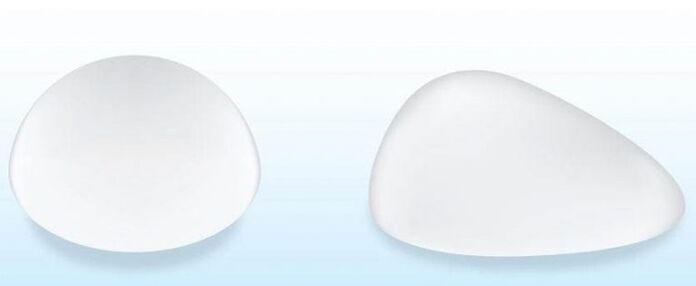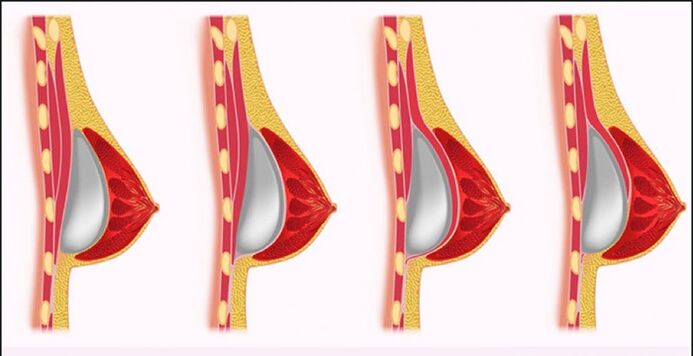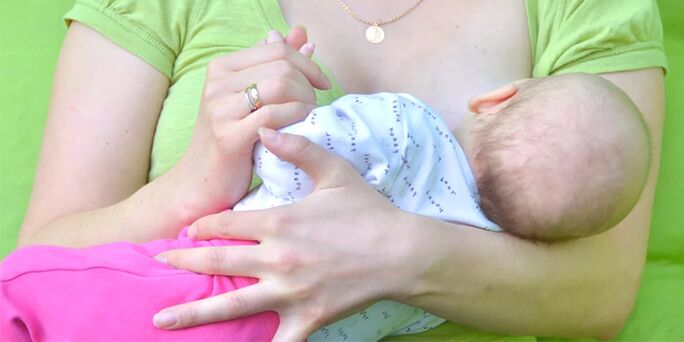Shape correction, breast augmentation is one of the most popular plastic surgery procedures. With the help of mammoplasty, you can correct congenital or acquired defects of the breast, restore its volume, elasticity after childbirth and breastfeeding. Properly performed surgery helps a woman become more attractive, more confident in herself.
Indications for surgery
- Decrease and decrease in the elasticity of the mammary glands (mastoptosis).
- Increase breast volume while maintaining its tone and position (macropathy).
- Reduction of mammary glands after lactation.
- Small breast size (micromastia).
- Increased breast volume in men (gynecomastia).
Types of mammoplasty
- Augmented mammoplasty(endoprosthetics) - breast augmentation, correction of its shape using implants. Used after childbirth, breastfeeding, with congenital asymmetry.
- Reduction mammoplasty- Reduction of bust size with mastoptosis or macropathy.
- Mastopexy- breast augmentation. Indicated for mastoptosis, if breast volume meets the requirements for surgery.
Endoprosthetics of the mammary glands
The operation involves the installation of silicone prostheses (implants) in the mammary glands. The choice of cutting site is in accordance with the woman. The implant is placed under the pectoralis muscle, and if breast volume allows, between the muscle and the mammary gland. The cut is sewn, no drainage required. The nipple and areola are enlarged after surgery.
Breast implants
Silicone or polyurethane endoprostheses correct the volume, the shape of the bust, give a feeling of natural body tissues.
The service life of implants exceeds 15 years, after which they are recommended to be replaced.

Products vary in a number of indicators:
- Filler: cohesive or saline gel (sodium chloride). The composition of the gels is more elastic, homogeneous, light, but dangerous to the body if leaked. The salt solution is safer, softer, cheaper. Negative characteristics - bubbles when moving, prone to leakage.
- Structure: rough (textured) or smooth. Textured implants are more durable, but skin folds can be displayed by rubbing body tissues against their surface. The disadvantage of smooth prostheses is the possibility of displacement.
- Shape: anatomical or round. The former have a more natural appearance, while the latter retain the symmetry and shape of the breast even when moved.
Reduction mammoplasty
When you perform this type of surgery, the adipose tissue and breast tissue are partially removed, their size changes and it is given a new shape.
Removal of excess tissue reduces the chance of cancer.
Mammoplasty reduction options:
- Liposuction. The method is considered conservative and leaves no layers. Designed for small breast reduction with mild mastoptosis degree.
- Short stitching (vertical). A popular method in which the breasts retain their natural shape and the nipples are sensitive. The operation requires little time and the complication rate is low.
- T-shaped cut (anchor). The classical method, which is used for large amounts of tissue removed. Its disadvantages are the duration of healing, a big scar.
- Nipple transfer amputation. Used for very large breasts. The method is associated with a high risk of damage to the mammary glands, loss of nipple sensitivity and inability to breastfeed.
Mastopexy
Removal of the breast without implant is possible in several ways:
- Vertical used for mastoptosis of 1-2 degrees, sutures are almost invisible, the cosmetic effect is long-term. The method is ineffective for lowering the breast 3-4 degrees.
- Anchor mastopexy gives good results for ptosis of any complexity. Its disadvantages include a longer healing period, visible sutures, an increased risk of breast tissue damage.
- Periareolar mastopexy is the removal of a small piece of skin around the areola. It has been shown for pseudoptosis, for other forms of bust fall it is ineffective.
Stages of operation
For an excellent result of plastic surgery, high quality medical care in all 3 stages is important. The preparatory period lasts 1-2 weeks. The actual surgical intervention lasts from 1 to 4 hours.
Complete recovery occurs within 1. 5 months.
Preparing for mammoplasty

The operation is performed no earlier than one year after the end of lactation. 2 weeks before surgery, it is forbidden to take hormonal contraceptives, Aspirin and preparations containing salicylates.
You need to stop drinking alcohol, smoking.
In preparation, the search is necessarily carried out:
- general and biochemical blood tests;
- electrocardiogram;
- blood test for anticoagulants (coagulogram);
- Ultrasound of the mammary glands;
- general urine analysis
- testing for hepatitis and HIV viruses.
Course of surgical intervention

Bust plastic surgery is performed under general anesthesia. A special type is extensor dermotension. Used to increase breast volume with its lack of tissue and large implant sizes. The procedure is performed in 2 stages. First, an expander is installed to gradually stretch the breast tissue for 1. 5-2 months.
When the desired size is reached, an endoprosthesis is placed in the breast.
Cutting operation methods:
- Through folding under the breast (submammary access). Safe method for enlargement mammoplasty. A scar from a 4-5 cm long incision disappears over time under a slightly lowered breast. Access is difficult with micromastiness in slender girls.
- An incision around or along the lower arch of the areola (periareolar approach). The advantage - surgical wounds are almost invisible. For patients planning to breastfeed, this method is not recommended due to the high risk of breast injury.
- Endoscopic augmentation through the axillary approach. High-tech equipment helps install the implant without damaging blood vessels and nerve fibers. A 3-4 cm long incision is made in the axillary area, and then the scar is masked naturally. There is a limit to the volume of the implant - up to 400 ml.
- Endoscopic approach through the navel. This method is rarely used due to the distance of the entry point from the site of surgery, difficulties with the formation of a "pocket" for the prosthesis.
Rehabilitation after mammoplasty

If the operation was performed without complications, the patient spends up to 3 days in the hospital. After unloading, it is necessary to follow the wardrobe. Moderate pain in the area of intervention that occurs in the first few days is considered natural. Feelings of tightness of the skin are possible due to postoperative edema, which disappears after about 5-7 days.
After 4-6 weeks, the breast shrinks slightly, looks more natural and capsules form around the implants.
Successful recovery rules:
- Do not load the shoulder girdle, do not lift weights.
- Do not visit fitness clubs, swimming pools, saunas, spas.
- Sleep on your back.
- Do not raise your hands.
- After breast augmentation, be sure to wear tight-fitting clothes.
Possible complications
- Capsular contracture. The body forms a shell around the endoprosthesis, which can lead to its displacement, violation of the symmetry of the mammary glands and their hardening.
- Infection. Infection occurs during surgery due to violation of the rules of asepsis or after non-compliance with antiseptic standards of care. The special risk period is 1 week after surgery.
- Keloid signs, hypertrophic. They appear if the body is predisposed to their formation. The formations look like dense ridges that rise above the surface of the skin and spoil the appearance of the breast.
- Accumulation of blood, serious fluid (hematoma, seroma) and, as a result, darkening of skin color. Occurs when blood vessels, lymphatic vessels are damaged during surgery or during the recovery period. Complication occurs due to low blood clotting, sharp increases in blood pressure, endoprosthesis of the wrong size.
- Reduction or loss of sensitivity of the nipples, areolas. It often occurs when the large breasts shrink with the reduction of mammoplasty due to nerve damage.
- Implant rupture. Occurs due to the thin shell, which is often found in cheap prostheses. The salt filler is easily absorbed by the body without causing harm. Damage to an endoprosthesis with a cohesive gel is not always noticeable, but it is dangerous if silicone enters the body tissues.
Breastfeeding after surgery

The safest operation is through an incision in the armpit (transaxillary) or under the breast (submandibular).
About a year after surgery, breastfeeding is allowed.
Lactation problems can occur in the following cases:
- The endoprosthesis is placed in order to compress the mammary glands, reducing the volume of milk they produce.
- An incision along the areola is more likely to damage the nerve endings around the nipple.
- Shrinkage plastic, associated with reducing breast size, disrupts milk ducts, blocking their functions.
In which cases is breast plastic surgery contraindicated?
- Cardiovascular diseases, varicose veins (thrombophlebitis, thrombosis).
- Severe forms of mastopathy.
- Oncology.
- Blood clotting disorders, diabetes mellitus.
- Infectious diseases (ARVI, influenza).
- Neurological, mental disorders.
- Pregnancy, breastfeeding.
- Age under 18 years.
Advantages and disadvantages of mammoplasty

Advantages of plastic breast correction:
- Application of modern interventions.
- Correction of congenital and acquired defects of the mammary glands.
- Long-term and pronounced aesthetic effect.
- Short operation times.
- Ability to choose the shape, the material of the endoprosthesis as desired.
- Maintain the ability to breastfeed.
Possible disadvantages include:
- Skin marks from incisions - sutures, wounds (unless special absorbent materials are used).
- Threat of complications (infection, breast deformity, bleeding).
- Need to change endoprostheses every 10-15 years.
- High cost of mammoplasty.
- The need for general anesthesia.
- Painful sensations in the first postoperative days.
- The need to constantly wear compression underwear.
- A long period of rehabilitation (from several months to a year) with refusal of sports, physical activity, pregnancy, breastfeeding.


























